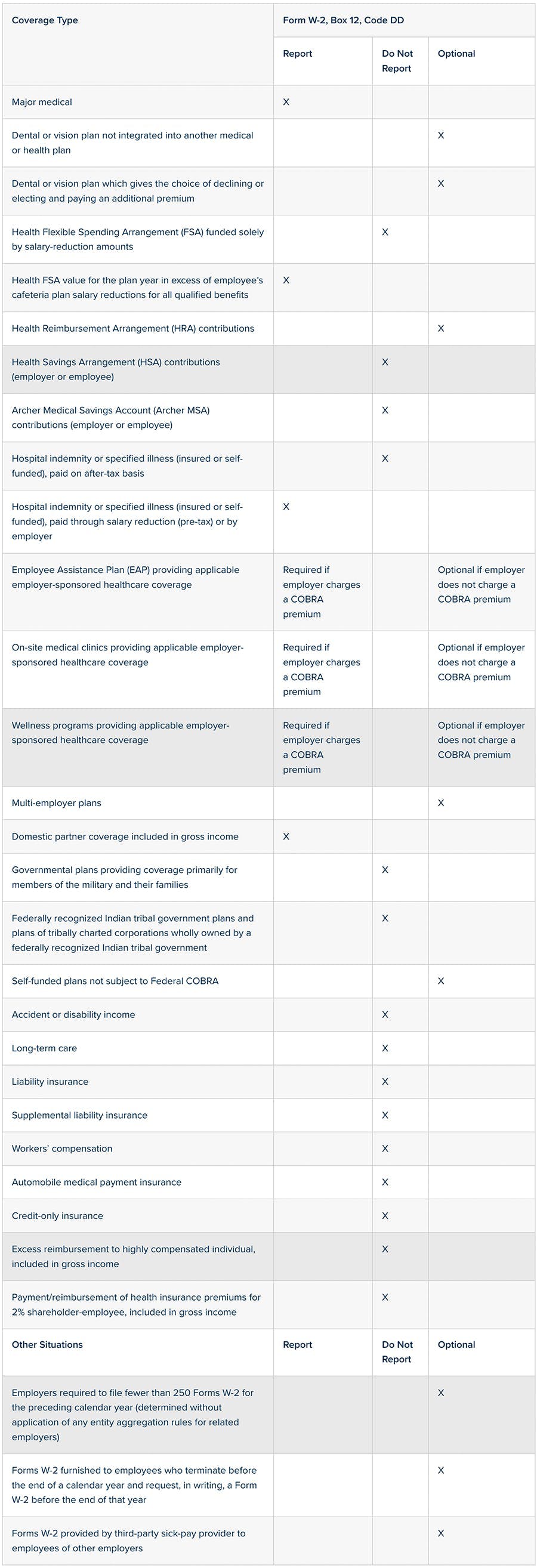ACA Form W-2 Cost of Coverage Reporting
By Brian Gilmore | Published December 1, 2017
Question: Which employers are subject to the ACA Form W-2 cost of coverage reporting? What coverage must be reported?
Compliance Team Response:
Employers Subject to Form W-2 Cost of Coverage Reporting
The Form W-2 cost of coverage reporting in Box 12 using code DD was added in the ACA, effective for 2012, and remains in effect. However, it currently applies only to employers that filed 250 or more Forms W-2 in the preceding calendar year.
Therefore, an employer is not required to report the Form W-2 cost of coverage until the calendar year following the first calendar year in which it files 250 or more Forms W-2.
If the employer did not file at least 250 Forms W-2 for the 2016 calendar year at the beginning of 2017, it is not subject to the Form W-2 cost of coverage reporting for the 2017 calendar year at the beginning of 2018.
Completing the Box 12 Code DD Reporting
If the employer is subject to the reporting, the cost of coverage must be reported in Box 12 using Code DD. It includes the full amount of the cost of coverage (i.e., both the employer-share and employee-share of the premium).
Where Can I Find More General Information?
The IRS has a helpful set of FAQs posted here: https://www.irs.gov/newsroom/employer-provided-health-coverage-informational-reporting-requirements-questions-and-answers
Which Coverage Must Be Reported
The IRS has a useful chart detailing what must be included here:
http://www.irs.gov/Affordable-Care-Act/Form-W-2-Reporting-of-Employer-Sponsored-Health-Coverage
Form W-2 Reporting of Employer-Sponsored Health Coverage
Regulations:
IRS Notice 2012-9: http://www.irs.gov/pub/irs-drop/n-12-09.pdf
Also, in the case of the 2012 Forms W-2 (and Forms W-2 for later years unless and until further guidance is issued), an employer is not subject to the reporting requirement for any calendar year if the employer was required to file fewer than 250 Forms W-2 for the preceding calendar year.
Q4. What transition relief is being provided by Notice 2012-9? To which employers and types of coverage does it apply and how long does it last?
For certain employers and with respect to certain types of coverage listed below, the requirement to report the cost of coverage will not apply for the 2012 Forms W-2 (the forms required for the calendar year 2012 that employers generally are required to provide employees in January 2013) and will not apply for future calendar years until the IRS publishes guidance giving at least six months of advance notice of any change to the transition relief. However, reporting by these employers and for these types of coverages may be made on a voluntary basis.
The transition relief applies to the following:
(1) employers filing fewer than 250 Forms W-2 for the previous calendar year (for example, employers filing fewer than 250 2012 Forms W-2 (meaning Forms W-2 for the calendar year 2012, which generally are filed with the SSA in early 2013) will not be required to report the cost of coverage on the 2013 Forms W-2 (which generally are filed with the SSA in early 2014). For purposes of this relief, the number of Forms W-2 the employer files includes any forms it files itself and any filed on its behalf by an agent under § 3504 (see Q&A-3 of Notice 2012-9 for more information). In addition, for purposes of this relief, the employer is determined without the application of any aggregation rules;

Brian Gilmore
Lead Benefits Counsel, VP, Newfront
Brian Gilmore is the Lead Benefits Counsel at Newfront. He assists clients on a wide variety of employee benefits compliance issues. The primary areas of his practice include ERISA, ACA, COBRA, HIPAA, Section 125 Cafeteria Plans, and 401(k) plans. Brian also presents regularly at trade events and in webinars on current hot topics in employee benefits law.
Connect on LinkedIn

